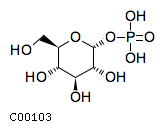
CHEBI:29042
| Name | alpha-D-glucose 1-phosphate |  Download: mol | sdf |
| Synonyms | 01-o-phosphono-alpha-d-glucopyranose; Alpha-d-glucose 1-phosphate; Alpha-d-glucose-1-phosphate; Cori ester; D-glucose 1-phosphate; D-glucose alpha-1-phosphate; Alpha-d-glucopyranose 1-phosphate; | |
| Definition | A D-glucopyranose 1-phosphate in which the anomeric centre has alpha-configuration. | |
| Molecular Weight (Exact mass) | 260.1358 (260.0297) | |
| Molecular Formula | C6H13O9P | |
| SMILES | OC[C@H]1O[C@H](OP(O)(O)=O)[C@H](O)[C@@H](O)[C@@H]1O | |
| InChI | InChI=1S/C6H13O9P/c7-1-2-3(8)4(9)5(10)6(14-2)15-16(11,12)13/h2-10H,1H2,(H2,11,12,13)/t2-,3-,4+,5-,6-/m1/s1 | |
| InChI Key | HXXFSFRBOHSIMQ-VFUOTHLCSA-N | |
| Crosslinking annotations | KEGG:C00103 | 3DMET:B04634 | CAS:59-56-3 | ChEBI:29042 | KNApSAcK:C00007482 | NIKKAJI:J40.065C | PDB-CCD:G1P | PubChem:3403 | |
| Pathway ID | Pathway Name | Pathway Description (KEGG) |
| map00010 | Glycolysis / Gluconeogenesis | Glycolysis is the process of converting glucose into pyruvate and generating small amounts of ATP (energy) and NADH (reducing power). It is a central pathway that produces important precursor metabolites: six-carbon compounds of glucose-6P and fructose-6P and three-carbon compounds of glycerone-P, glyceraldehyde-3P, glycerate-3P, phosphoenolpyruvate, and pyruvate [MD:M00001]. Acetyl-CoA, another important precursor metabolite, is produced by oxidative decarboxylation of pyruvate [MD:M00307]. When the enzyme genes of this pathway are examined in completely sequenced genomes, the reaction steps of three-carbon compounds from glycerone-P to pyruvate form a conserved core module [MD:M00002], which is found in almost all organisms and which sometimes contains operon structures in bacterial genomes. Gluconeogenesis is a synthesis pathway of glucose from noncarbohydrate precursors. It is essentially a reversal of glycolysis with minor variations of alternative paths [MD:M00003]. |
| map00040 | Pentose and glucuronate interconversions | NA |
| map00052 | Galactose metabolism | NA |
| map00500 | Starch and sucrose metabolism | NA |
| map00520 | Amino sugar and nucleotide sugar metabolism | NA |
| map00521 | Streptomycin biosynthesis | Streptomycin is an aminocyclitol-aminoglycoside antibiotic produced by Streptomyces griseus. Streptomycin consists of aminocyclitol (streptidine), 6-deoxyhexose (streptose), and N-methyl-L-glucosamine moieties, which are formed by independent biosynthetic pathways. All of the moieties are derived from D-glucose. The streptidine moiety is synthesized via myo-inositol, which is then oxidized at C-1 and transaminated to give scyllo-inosamine. After phosphorylation, the compound is transamidinated by arginine. The same procedure is repeated at the C-3 position. The streptose moiety is made from D-glucose via a dTDP-glucose pathway. The exact biosynthetic route for the N-methyl-L-glucosamine moiety is unknown, though the biosynthetic gene cluster have been proposed. |
| map00523 | Polyketide sugar unit biosynthesis | NA |
| map00525 | Acarbose and validamycin biosynthesis | NA |
| map00561 | Glycerolipid metabolism | NA |
| map01060 | Biosynthesis of plant secondary metabolites | NA |
| map01100 | Metabolic pathways | NA |
| map01110 | Biosynthesis of secondary metabolites | NA |
| map01120 | Microbial metabolism in diverse environments | NA |
| map01130 | Biosynthesis of antibiotics | NA |
| map04922 | Glucagon signaling pathway | Glucagon is conventionally regarded as a counterregulatory hormone for insulin and plays a critical anti-hypoglycemic role by maintaining glucose homeostasis in both animals and humans. To increase blood glucose, glucagon promotes hepatic glucose output by increasing glycogenolysis and gluconeogenesis and by decreasing glycogenesis and glycolysis in a concerted fashion via multiple mechanisms. Glucagon also stimulates hepatic mitochondrial beta-oxidation to supply energy for glucose production. Glucagon performs its main effect via activation of adenylate cyclase. The adenylate-cyclase-derived cAMP activates protein kinase A (PKA), which then phosphorylates downstream targets, such as cAMP response element binding protein (CREB) and the bifunctional enzyme 6-phosphofructo-2-kinase/ fructose-2,6-bisphosphatase (one of the isoforms being PFK/FBPase 1, encoded by PFKFB1). |

